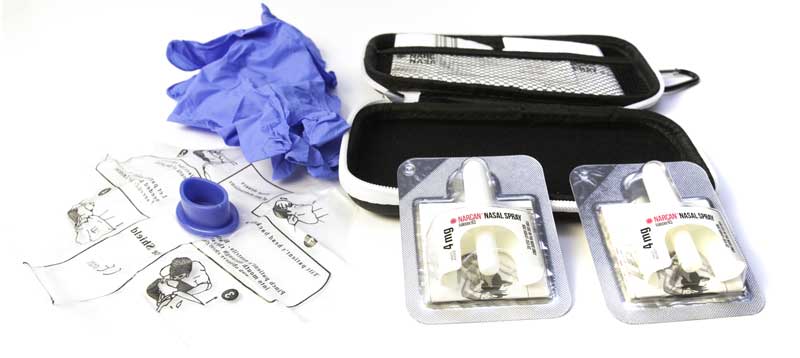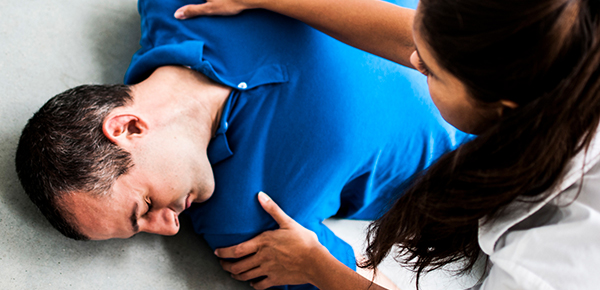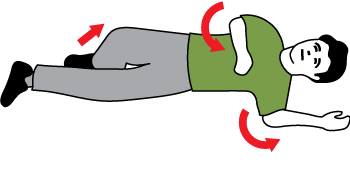
Opioids
On this page:
What are Opioids?
Fentanyl
Short- and Long-Term Effects
Preventing Opioid or Substance-Related Poisonings
Naloxone (Narcan)
Helping Someone Experiencing an Opioid or Substance-Related Poisoning
Harm Reduction
Treatment and Services
Additional Resources
The toxic drug supply is a public health and safety concern affecting many communities. In 2023, 2647 Ontarians died from opioid-related causes; 31 of those deaths occurred in the Eastern Ontario Health Unit region. The scale of opioid- and stimulant-related harms in Ontario is reflected in this interactive tool by Ontario Public Health.
The term “poisoning” should be used:
"Overdose" may be a widely accepted term and is even in the name of the Good Samaritan Drug Overdose Act, but it's not accurate in describing what is happening in the body. The term "overdose" can be used to describe an action that can lead to a poisoning. For example, if a person over-consumes alcohol, we call it alcohol poisoning. We don't call this an alcohol overdose.
Overdose implies that we are taking too much of a medication or a substance, but there is no safe dose for street drugs that may have been mixed with unknown dangerous substances. Thus, poisoning is a more appropriate term.
Words matter. For some, the term “overdose” implies personal failure and responsibility. This can increase stigma. Using the term “poisoning” to accurately reflect the medical process can prevent moral judgments and confusion.
What are Opioids?
Opioids are a broad group of narcotic medications that are primarily used to treat acute and chronic pain. They can be classified as:
- natural (derived from the poppy plant, such as opium, morphine, codeine, etc.)
- semi-synthetic (derived from one of the natural opiates like oxycodone, buprenorphine, etc.)
- synthetic (when chemical precursors are used, like fentanyl, methadone, tramadol, etc.)
Opioids are consumed for medical and non-medical purposes. When used as directed by your doctor or pharmacist (this includes when to take them, how often, and for how long), they can help. Opioids have the potential to cause problematic use because they can produce a feeling of well-being or euphoria – a “high.” Misuse can cause dependence, poisoning, and even death.
Fentanyl
One opioid of concern is fentanyl, a highly toxic and synthetic opioid that can be prescribed to patients or acquired from an unregulated source. The presence of fentanyl, which can be fatal even in trace amounts, in other substances dramatically increases the risk of a poisoning.
Fentanyl for Medical Purposes
Fentanyl is an opioid drug prescribed to treat acute and ongoing severe pain. Opioids are a depressant drug. This means they can be dangerous when not used as prescribed by a medical professional because they can dangerously slow down breathing. Fentanyl for medical purposes comes in different forms and is manufactured under strict guidelines in a controlled environment.
If you have prescription opioids in your home, make sure you store them out of the reach of children to avoid unintentional poisonings. If your kids are older, keep track of the prescription medications in your medicine cabinet to prevent them from being taken to get high. If you have expired, unwanted, or unused prescription drugs, the best way to keep your family and pets safe is to bring them to your local pharmacy for disposal. If you live in the Cornwall area, you can also drop off your unused medications at Medi Drop collection boxes located throughout the city.
Fentanyl for Non-Medical Purposes
Fentanyl for non-medical purposes can come from two sources:
- Unregulated drug labs
- Fentanyl medications that have been sold by or stolen from people they were prescribed to
These drugs are extremely dangerous. They can be found in multiple forms and can be hidden in other street drugs. They can also be sold on the street as a different form of counterfeit pain medication like Oxycontin or Percocet. Given the toxic drug supply, one never knows what they’re getting when buying street drugs.
Fentanyl made in unregulated drug labs is dangerous because there is no quality control. There are currently many different types of fentanyl, each one having a different level of toxicity. One type, called carfentanil, is a cause for concern as the toxicity of this drug can lead to increased harms and deaths, even among individuals who have a tolerance to opioids.
Short- and Long-Term Effects
The short- and long-term effects of opioid use may include, but are not limited to:
| Short-Term | Long-Term |
|
|
The effects can differ from person to person as they are dependent on a variety of personal factors.
Signs of an Opioid Poisoning
Poisonings can happen when you take an opioid. Opioids slow down the part of the brain that controls breathing, which can result in death if breathing stops. People experiencing an opioid poisoning may show one or more of the following signs:
- Nodding off, not waking up easily, or unresponsive
- Breathing very slowly, or not at all
- Blue/grey lips and fingernails
- Cold and clammy skin
- Limp, tense, or shaking body
- Snoring or gurgling
- Foaming at the mouth or throwing up
Preventing Opioid or Substance-Related Poisonings
The best way to prevent a drug poisoning is to only use medications prescribed to you, as directed by your doctor or pharmacist. This includes when to take them, how often, and for how long.
If you are going to use an opioid or substance that was not prescribed to you:
- Get and carry a free naloxone kit that can help reverse the effects of an opioid poisoning.
- Use substances only where help is available.
- Never use alone.
- Use only around people you trust.
- Ensure that not everyone is using at the same time.
- If you are going to use alone:
- Call the National Overdose Response Service at 1-888-688-6677. A non-judgmental peer will stay on the line with you for approximately 30 minutes to provide support if needed.
- Use The Brave app. This anonymous, private, and caller-led app aims to keep a person safer from overdose by providing them access to a supporter who can trigger their emergency response plan if they are at risk of a poisoning.
- Take a test dose and wait before taking more.
- Start low and go slow. Many street drugs can be cross contaminated with other substances. If you haven’t used in a few days, decrease your dose, and slowly increase.
- Use only one substance at a time.
- Don’t mix with alcohol or other medications and/or substances (except as prescribed by a medical professional).
- Use only new drug paraphernalia.
- Avoid sharing paraphernalia with other individuals to reduce your risk of getting or passing on an infectious disease.
Naloxone (Narcan)
Anyone who uses opioids, whether obtained by prescription or from an unregulated source, is at risk of an opioid poisoning. Opioids can cause breathing to slow or stop. Naloxone can reverse the effects of an opioid poisoning temporarily, restoring breathing within a few minutes. Naloxone is a safe, non-addictive medication, and has no effect if opioids are not present.
Free Naloxone Distribution Program
If you are a person who uses opioids or a friend or family member of a person who uses opioids, you can get a free naloxone kit at the EOHU. Walk into any EOHU location during office hours and ask for a kit at reception. Training can be provided.
Many local pharmacies and community partners also provide free naloxone kits. To find the nearest location carrying naloxone, visit www.Ontario.ca/OpioidOverdose.
What is a Naloxone Opioid Poisoning Prevention Kit?
Naloxone can temporarily reverse the effects of an opioid poisoning, which allows time for the person to get to a hospital to receive medical treatment. Along with chest compressions and/or rescue breathing, it can help revive someone who is experiencing an opioid poisoning. If you have a naloxone kit, you should always carry it with you, especially if you’re going to be using opioids or other substances. It's important to note that naloxone treatment does not replace the need to seek immediate medical attention. Call 911 immediately if you suspect an opioid poisoning.
The naloxone kit contains the following:
- non-latex gloves
- a rescue breathing barrier
- product monograph
- two doses of nasal spray naloxone (some pharmacies only provide the injectable naloxone)
- one identifier card

Naloxone should be stored at room temperature and in the dark. Keeping it in the container it comes in will preserve it well. Like other medications, naloxone has an expiry date. Ensure to check the expiry date of your naloxone, and if it has expired, return it to a pharmacy or to the Eastern Ontario Health Unit (EOHU) for proper disposal and to replace your kit.
Helping Someone Experiencing an Opioid or Substance-Related Poisoning

If you suspect someone is experiencing an opioid or substance-related poisoning, taking the following steps can help save their life:
- Shake and shout (try to stimulate the person so they wake up)
- Call 911
- Use a naloxone opioid poisoning prevention kit
- Use chest compressions and/or rescue breathing
- Reassess after 2 to 3 minutes. Give an additional dose of naloxone if there’s no change in the person, and resume chest compressions and/or rescue breathing
- Place the person in the recovery position if they wake up (see below)
Since naloxone reverses the effects of opioids, the person who is administered the drug may go into opioid withdrawal and experience the following symptoms:
- Nervousness
- Restlessness
- Body aches
- Diarrhea
- Vomiting
- Nausea and stomach pain
How You Can Put Someone Who Has Been Poisoned in the Recovery Position
Step 1: Put the person’s arm that is closest to you at a 90-degree angle and tuck it behind their head to use as a pillow. Cross the other arm over their chest and raise the furthest knee at an almost 90-degree angle.
Step 2: Grab the person’s furthest leg and arm. Move them towards you (the person should roll towards you).
Step 3: Put the person in a comfortable position that supports their head. Stay with the person until help arrives.

Good Samaritan Drug Overdose Act
The federal Good Samaritan Drug Overdose Act (effective May 4, 2017) provides some legal protection for individuals who seek emergency help if experiencing or witnessing a substance-related poisoning.
Good Samaritan Drug Overdose Act: Poster
Harm Reduction
Harm reduction is an evidence-based, client-centered approach that aims to reduce the risks and harms associated with addiction and substance use, without requiring people who use substances from abstaining or stopping. It acknowledges that abstinence is not a goal for some people.
EOHU Harm Reduction Strategy
The EOHU offers harm reduction services — without judgment — to people who use substances and friends and family of people who use substances.
The free naloxone kit distribution program is one element of the EOHU’s harm reduction strategy. The EOHU also provides other free harm reduction materials, including safe injection and inhalation equipment, education, and the support needed to reduce the harms associated with substance use. The EOHU harm reduction team will also refer individuals to other health and social services that align with their needs.
Harm reduction materials and services are available from EOHU office locations. To access these materials and services:
- Naloxone: Walk into any EOHU location during office hours and ask reception for a kit. Training can be provided.
- Other harm reduction services in the office: Walk into any EOHU location during office hours and ask reception for a kit that contains harm reduction supplies (supplies to use drugs more safely). If the kit does not contain the supplies you need, a nurse can consult with you. If there is no nurse available, an appointment can be made.
The EOHU also operates a mobile harm reduction van most Tuesdays, within the city of Cornwall.
The following materials are available to decrease the risks associated with substance use, including blood borne infections such as hepatitis B, hepatitis C, and HIV:
- syringes
- tourniquets
- sterile water
- vitamin C (acidifiers)
- cookers
- alcohol swabs
- crack pipes (glass stems)
- screens
- mouthpieces
- bowl pipes
- push sticks
- foils
- filters
- condoms for males/females
- dental dams
- lube
- biohazard containers
In addition, the following used materials can be returned to the EOHU for proper disposal:
- Biohazard containers filled with used syringes, stems, and bowl pipes
For more information about the naloxone kit distribution program and the EOHU’s harm reduction programs, contact us.
The EOHU also operated a mobile harm reduction van most Tuesdays, within the city of Cornwall.
Other community partners also offer harm reduction supplies and services:
- For a map of locations that distribute harm reduction supplies visit Ontario Harm Reduction Distribution Program.
- Two other mobile units operate in Cornwall and Prescott and Russell.
- The Youth Hub’s Hawkesbury outreach site offer harm reduction services. Look for Public Health Nurse on the schedule.
Treatment and Services
If you or someone you know needs support, there are several options for free, confidential help for people with addiction concerns.
For more information and to get help:
- Find mental health and addiction services in your community (Ministry of Health)
- ConnexOntario, call 1-866-531-2600
- AccessMHA.ca
- 1Call1Click, call 1-877-377-7775
- Help for infants, children, and youth from birth to 21 years of age. Connecting local children, youth, and families to the right mental health, substance use, and addiction services.
- Cornwall Community Hospital Addiction Services, call 613-361-6363
- Hawkesbury General Hospital’s Mental Health and Addiction Services, call 1-844-304-1414
- Recovery Care
- Change Healthcare, call 1-877-937-2282
- TrueNorth Addiction Treatment, in Akwesasne, and in Alexandria.
Additional Resources
Awareness resources for opioids (Government of Canada)
Parent’s Guide to Fentanyl (Drug Rehab Services Canada)

